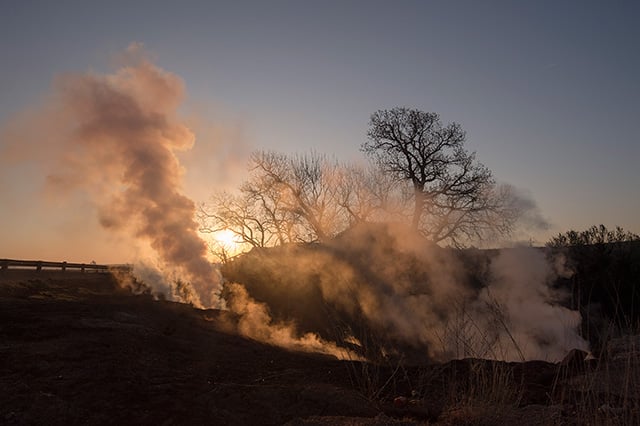Kansas was recently ravaged by the largest wildfire in its history. The Anderson Creek wildfire burned through roughly 400,000 acres of Kansas and Oklahoma over the course of four days last week, stymied only by an unseasonable snowfall on Easter morning.
Kansas’ Republican Gov. Sam Brownback signed a state of disaster emergency declaration for five counties last week. His state has been facing frequent abnormalweather, mostly in the form of unusually warm temperatures, which predispose it to record wildfires.
What we are seeing in Kansas is simply the micro of the macro, a symptom of a world that is increasingly susceptible to burning. We live on a planet that is approaching a global temperature increase of 1.5 degrees Celsius above preindustrial average temperatures: a level not seen in the last 110,000 years.

Smoke rises along US Route 160, west of Medicine Lodge, Kansas, following a wildfire that ravaged the area, March 26, 2016. The blaze, which has scorched nearly 400,000 acres, is said to be the largest recorded wildfire in the state’s history and has prompted a vast mobilization of firefighters rarely seen in this state. (Photo: Craig Hacker / The New York Times)
Hotter, Longer, Larger
As Truthout reported this week, “NASA recently released data confirming that February was the warmest month ever measured globally, at 1.57 degrees Celsius above the preindustrial baseline temperature average. The new record easily smashed the old global temperature record, which was set just one month before, in January.”
Hence, it should not come as a surprise that the record temperatures ushered in a record wildfire, and have us set up for what may well be yet another record wildfire season in the United States.
The Union of Concerned Scientists (UCS), a group that describes itself as putting “rigorous, independent science to work to solve our planet’s most pressing problems,” provides a sobering overview of how anthropogenic climate disruption (ACD) is contributing to wildfires. UCS research shows that wildfires in the Western United States are increasing in number, and wildfire season is becoming longer, due to ACD.
For example, the average number of annual wildfires larger than 1,000 acres was 140 per year between 1980 and 1989, but has increased dramatically to 250 per year between 2000 and 2012.
Additionally, the average length of the wildfire season was five months during the early 1970s, whereas now it is more than seven months long and increasing.
UCS research shows that another contributing factor to the escalation of wildfires across the Western United States is the fact that the winter snowpack is melting up to a full month earlier than it did in previous decades, and wildfires are now projected to burn more land than ever in the future.
Other prominent studies support what the UCS has found. Researchers from the University of Utah released a report showing that over the last three decades, wildfires across the Western United States have, indeed, been growing both larger and more frequent.
Meanwhile, anecdotal evidence from around the world continues to present itself in more dramatic fashion as time goes by.
“In Tasmania, bushfires have grown so severe that 1,000-year-old trees are burning to ash while dried-out peat bogs are rapidly catching fire,” Truthout reported this week. “Experts there are warning that what is happening in Tasmania is a human-caused calamity as severe as the razing of the temples in Palmyra by ISIS” (also known as Daesh).
Meanwhile, in Indonesia, 2015 was the worst wildfire season in the country’s history. By mid-October, the island nation saw more than 100,000 individual fires. Damages in that month alone reached more than $30 billion, and more than half a million people were reported sick from the smoke.
“In [the] next 30 years, we’re looking at pretty consistent disruption of current fire patterns for over half the planet — most of which involve increases” in severity, Max Moritz, a fire specialist based at the University of California, Berkeley’s College of Natural Resources, warned back in 2012. His words are even more relevant today, as we head into what may be this planet’s worst wildfire season yet.